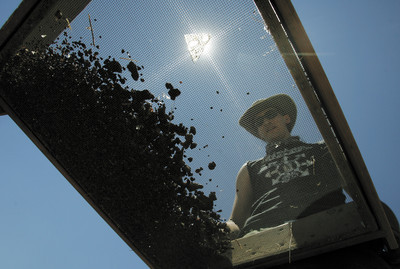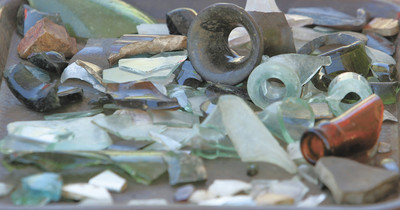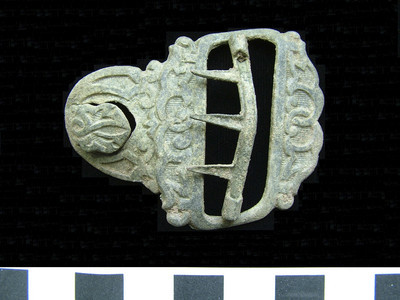Digging into city’s seedy past
VIRGINIA CITY -- Kate Cousineau was excited as she walked over with a fragment of a comb and what appeared to be a large glass bead the size of a marble.
She and colleague Sara Gray had just unearthed the items in a pit they were excavating at the south end of this famed mining town, an area of vice and crime known as the "Barbary Coast."
Were the discoveries tangible evidence of that colorful past in this 19th century mining town?
"I hope it's not plastic," Cousineau said of the comb fragment. "That would be discouraging."
The artifacts were tagged and bagged at the dig's processing area.
The Barbary Coast, a once lively but seedy area of bars, shooting galleries and prostitutes, is now only a memory.
All that remains are pieces of building foundations built into the slope of the Virginia range, which rises steeply to the west. But beneath the dirt and debris, evidence might be waiting to be found that could shed more light on the area's past.
Finds might suggest what businesses were located in the area and whether, as later accounts suggest, it was the scene of prostitution or other illicit activities during the heyday of the Comstock Lode.
It is the tantalizing knowledge that an important discovery might be just an inch farther into an excavation pit that keeps the budding archaeologists at their task in the hot sun.
The conclusion on the comb and bead? Too soon to tell. The artifacts were logged in and packed in plastic sandwich bags for transport back to the University of Nevada, Reno, for further analysis.
So back to the pit, one of several being excavated just west of C Street, the main drag of what once was one of the most important cities between Denver and San Francisco, looking for that next find.
Ten students with a summer field school from the Reno university's Department of Anthropology have been excavating for about two weeks at the site.
Sarah Heffner, one of the supervisors of the dig and a graduate student in anthropology, said the excavations are mainly test pits that will be used to determine building locations and their uses.
The information will be used for future digs, she said.
"It's a very rich area," Heffner said. "No major finds yet. But the thing with archaeology is it's usually the last day you find something."
The archaeologists have found bottles, a belt buckle, buttons and a garter belt clip, among several items.
State Historic Preservation Officer Ron James said the dig is looking for information about the early days of the mining town, of which not a lot is known.
The period of the early 1860s, the time when Mark Twain was a resident while working for the Territorial Enterprise newspaper, has a lot of holes in the historical record.
"The newspapers from that period were largely burnt," James said. "Photography was in its infancy. There was a lack of firsthand observation. It's annoying what we don't get."
That's why archaeology is so important, he said.
Any dig in the Barbary Coast area could produce some interesting finds.
"It was described as one of the raunchiest areas imaginable in comments from the 1870s," James said. "There was drug use and prostitution. It was where the seediest washouts of society hung out."
Although there are no specific accounts of Twain visiting the area, it's hard to imagine him not going there, even if just for the purposes of seeing it, he said.
"It's the kind of a place where, if you were a young, single male, you would go just to see, it seems to me," James said.
There are sites in Virginia City that date to Twain's days, although much of the town has been lost to fire and general decay over the decades. The entrance area of Piper's Opera House, the Washoe Club and the Gold Hill Hotel are a few of the survivors of that time, James said.
At the dig, the student-archaeologists continued to scrape away layers of debris, looking for building foundations and artifacts.
At another test hole, the remains of wooden barrels had been uncovered.
"I think this was a trash heap," said Chris Harrington, one of the archaeologists. "We found an ornate glass stopper."
Heffner said trash heaps are a great find for archaeologists, because they shed a lot of light on an era.
Cousineau, a recent graduate from UC Berkeley in anthropology, said she joined the dig because "I'm a big fan of Mark Twain. I was suckered in; I have to admit it."
Gray said the dig is a great chance to think about who lived in the area and what life was like nearly 150 years ago.
"We were having a lot of fun thinking about what was happening over here because we found bits and pieces of what could be luxury goods. Maybe the historical record was wrong."
Contact capital bureau reporter Sean Whaley at swhaley@reviewjournal.com or 775-687-3900.



















